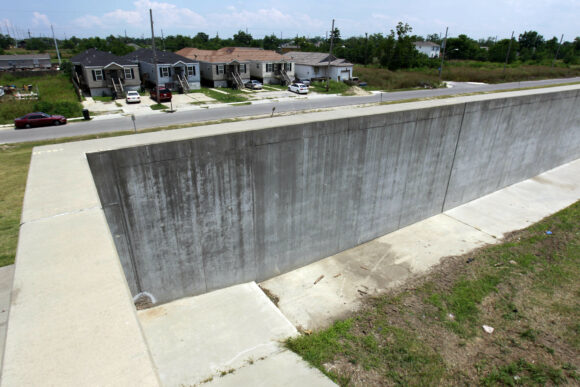BATON ROUGE, La. (AP) — After Hurricane Katrina, Louisiana delayed paying its debts for improvements to the federal flood protection system stretching across five parishes in the New Orleans area. The massive bill totaling as much as $3 billion is coming due, leaving the state sifting through unpleasant financing scenarios.
Gov. John Bel Edwards is asking lawmakers to consider borrowing more than $1 billion across several years to repay the federal government more quickly and lessen the tremendous interest that otherwise would be owed. But that could put a sizable crimp in money available for other state-financed construction work.
None of the options available to the Democratic governor and lawmakers is a quick or cheap fix. But they’ve known about this liability hanging out there for years, a situation created by their predecessors.
“We have a debt for the levee system in southeast Louisiana that occurred on other people’s watch,” said Senate President Page Cortez, a Lafayette Republican, as he lamented the available repayment choices to the joint House and Senate budget committee.
“I don’t think we have many good options,” he said.
The state had limited bargaining leverage with the federal government years ago when Louisiana was reeling from Katrina and needed to unlock billions in federal money to repair the flood protection system’s damage and make improvements to protect the region from future storms.
After Katrina devastated the New Orleans region in 2005, the U.S. Army Corps of Engineers embarked on a multibillion-dollar hurricane-protection system across Orleans, Jefferson, St. Bernard, Plaquemines and St. Charles parishes.
The agreement, finalized in 2009 under former Gov. Bobby Jindal with help from Louisiana’s congressional delegation, called for the federal government to pay the full cost of rebuilding the Corps’ flood-control system that failed during Katrina, along with additional structures authorized in 1965 that weren’t complete when Katrina hit.
The agreement also called for sharing the cost of building new projects to help the region withstand a 100-year storm – such as floodgates, pump stations and surge barriers. The federal government committed to paying 65 percent of those costs, and fronting 35 percent to be repaid by the state.
The deal didn’t require the state to begin repaying its share for a decade, but the interest began accumulating immediately.
That specific detail has rankled lawmakers and Edwards, who have called it unfair, particularly since the Corps’ work on 350 miles of levees and 73 pump stations has taken years longer than promised and concerns have been raised about structural problems with some of the work.
The debt repayment requirement is about to begin, and Edwards and lawmakers are looking for payoff options.
Louisiana’s congressional delegation worked on a plan approved by their colleagues in December. The deal will allow a forgiveness of construction interest charged on the projects if the state pays off the debt by September 2023, with a first payment of $400 million due by Sept. 30, according to Commissioner of Administration Jay Dardenne, the governor’s chief budget adviser.
In his budget presentation to lawmakers, Dardenne outlined the Edwards’ administration proposal to borrow $400 million in the next financial year through a bond sale to investors, followed by additional bond sales in upcoming years.
That would pay off the debt to the federal government by the deadline outlined in the congressional relief provision _ and could save the state $1 billion or more in interest charges _ because the state could finance its borrowing at a lower interest rate that it pays off over two decades, Dardenne said.
If the state follows a 30-year repayment plan directly to the federal treasury with interest, the cost would be an estimated $3 billion, he said.
“The difference in savings to the state is staggering,” Dardenne said. “Our delegation has paved the way for us to save this money.”
Such a borrowing plan would need approval from the State Bond Commission, a panel of elected officials and key legislative leaders.
The arrangement, however, would lock up borrowing capacity that could otherwise be used for state and college campus building repairs, roadwork and other state-financed construction projects.
Cortez said the decision is a difficult one. But he acknowledged: “I’m not sure we have any other options.”
Either way, Louisiana will be paying the debt off for decades.
About the photo: In this May 15, 2012 file photo, the new levee wall constructed with reinforced concrete, is shown at one of the breach sites from Hurricane Katrina, in the Lower 9th Ward in New Orleans. Louisiana’s estimated share of the costs for federal levee work in the New Orleans area has ballooned to $3 billion because the U.S. Army Corps of Engineers is charging interest on the debt. Louisiana’s first payment is due in August 2020, with $100 million estimated to be owed annually for 30 years. (AP Photo/Gerald Herbert, File)
Was this article valuable?
Here are more articles you may enjoy.


 Toyota Unveils Concept LFA Supercar, and It’s Fully Electric
Toyota Unveils Concept LFA Supercar, and It’s Fully Electric  California Again Delays Wildfire Protection Rules for Homes
California Again Delays Wildfire Protection Rules for Homes  OpenAI And Microsoft Sued Over Murder-Suicide Blamed on ChatGPT
OpenAI And Microsoft Sued Over Murder-Suicide Blamed on ChatGPT  Losses Top $20 Billion in Asia Floods as Climate Risks Grow
Losses Top $20 Billion in Asia Floods as Climate Risks Grow 